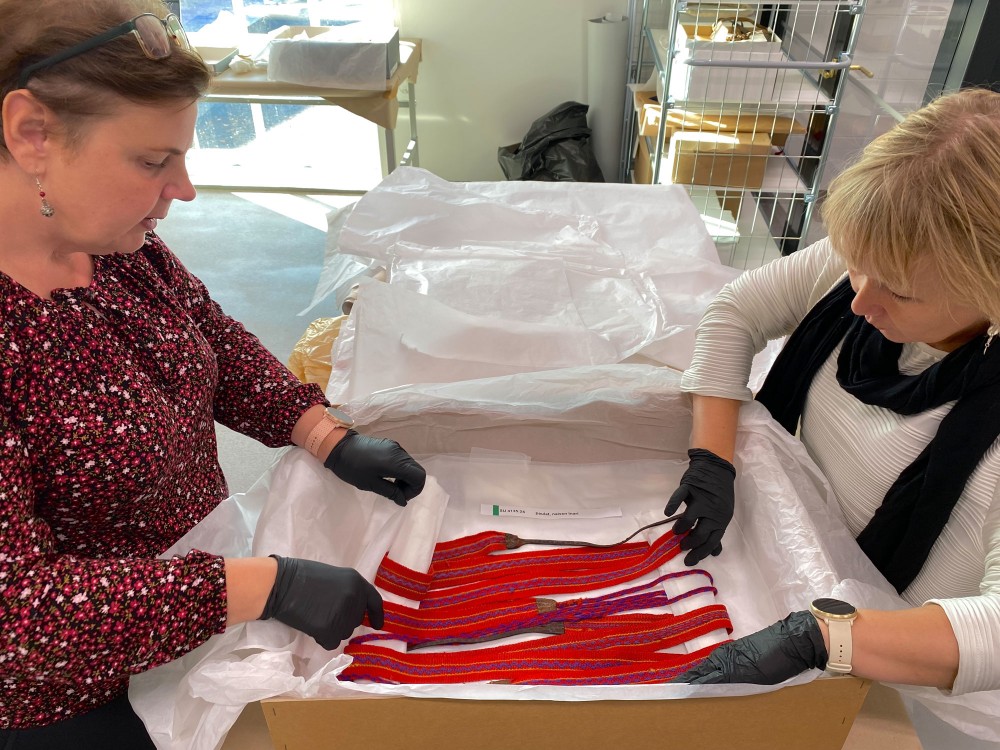More than 2,200 Sámi artifacts are returned by the National Museum of Finland
Some will eventually go on permanent display the the Siida Museum in northern Finland.

More than 2,200 Sámi artifacts have been returned to the Sámi area by the National Museum of Finland. The idea was already brought up 10 years ago and since then the cooperation between Siida Museum and the National Museum of Finland has been close and valuable.
The artifacts range from utility articles such as gloves and knives to bigger subjects such as whole buildings and boats.
For the team at Siida Museum, it is like Christmas. Boxes and boxes full of precious items are waiting to be unraveled and examined, and the team does not know what each box contains.
“Now the real research begins,” says Eija Ojanlatva, archeologist and Substitute Museum Director at Siida museum. “It was a terrific sight when the trucks arrived, after the first shipment the amount of boxes that we had was incredible,” she continues.
The repatriation has an important meaning for the Sámi communities. The collection has items from all over Sámi area as well as from Petsamo area, collected before relocation on the Skolt Sámi from the area. Over the recent years there has been a lot of discussion over repatriation globally, which in this case means the process of returning something to their place of origin. The items were bought by collectors from Sámi areas and eventually made their way to the National Museum of Finland. The oldest artifacts come from the late 18th century and the newest from the early 20th century. According to archeologist Ojanlatva, there is very little information on some of the items. “We have information on what the item is, estimate on where the item is from, but not more than that. Sometimes there is no information on when it was made or who the owner was,” she says.
Because of this, Siida museum is working closely with the local Sámi communities. The museum is asking for help from the older generation, who might recognise certain items, patterns or designs that belong to a specific area or family. “We are getting the information now from the Sámi communities, which is really valuable to us. I see that our work in communality is only beginning now that we have received these artifacts,” Ojanlatva says.
Previously, if a person wanted to see these items in the National Museum of Finland, they had to travel more than 1,000 kilometers, book a time slot to the collection and have a rough idea of what they wanted to see. Ojanlatva hopes that the process will be smoother now.
“What is perhaps most important is that the artifacts are managed by a Sámi organisation,” Ojanlatva says. She goes on to explain that former president of the Sámi Parliament of Finland, Tiina Sanila-Aikio, has mentioned that the Siida museum is implementing the cultural autonomy of the Sámi people. They are also the only organization in Finland that actively captures Sámi culture for the future generations as well — whether that is oral history, material history or archival information.
Even though the artifacts have been returned to their home, Ojanlatva says that the National Museum of Finland still has a responsibility to educate their visitors about the Sámi. Next, a homecoming exhibition will start in the National Museum of Finland, with some 150 artifacts on show. In the future, the exhibition will travel around in different countries, and the team in Siida museum will start discussions on where the exhibition will travel to.
The repatriation comes as the museum is undergoing big renovations; it’s renewing its permanent exhibition and building new facilities which will be able to host the new artifacts.
Next, the team at Siida museum must determine which items will go to the permanent collection.
“We have certain items that we know we want there, but we cannot really tell before we estimate the condition of the items. Can we use them as they are or do they need to be conserved?” Ojanlatva says.
The museum renovations are underway and Siida museum will open officially on April 1 2022.

